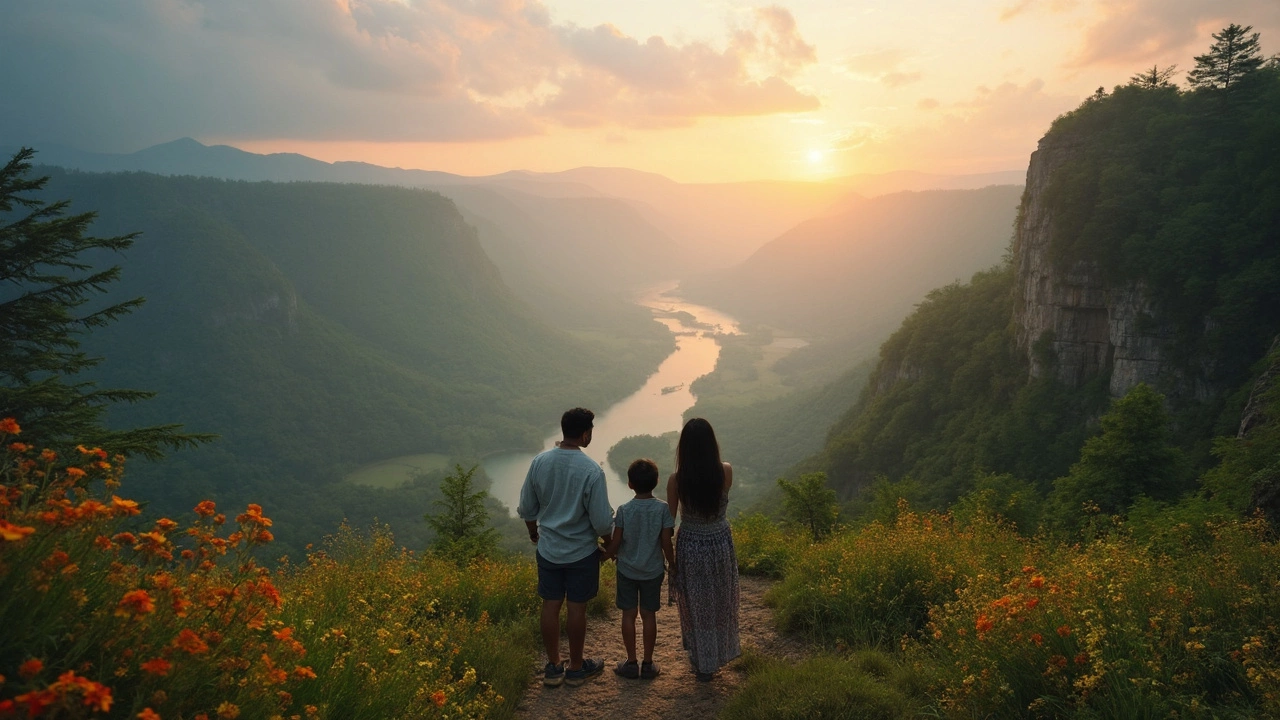If you ask ten people about the most scenic spot in the US, you’ll probably get ten different answers. But when it comes to hill stations—those cool, high-altitude towns with awesome views—one place stands out. The Blue Ridge Mountains honestly look like someone hit pause on the world and then cranked up the beauty filter.
Why do so many travelers love these hills? It’s simple. The rolling, misty peaks stretch for miles, with winding roads, waterfalls, and small-town charm around every corner. You can drive the Blue Ridge Parkway and feel like you're floating above a sea of trees, especially when that morning fog rolls in. Every season brings its own wow factor, from fall’s wild splash of colors to spring’s blooming rhododendrons.
Here’s what’s cool: you don’t need a ton of hiking experience (or expensive gear) to enjoy it. Whether you want to relax with a cup of strong coffee overlooking the valleys or hit a famous trail, you’ll find something that fits your vibe. And you can snag views just steps from your parking spot—no epic trek required. If you’re ready to level up your Instagram game, this is the place.
- What Makes a Hill Station ‘Scenic’?
- Meet the Crown Jewel: The Blue Ridge Mountains
- Things You Have To Do There
- When to Visit and How to Get Around
What Makes a Hill Station ‘Scenic’?
Not every mountain town deserves the spotlight. So what sets one hill station apart from all the others? A scenic place usually checks a few major boxes, and, honestly, it's not as mysterious as it sounds. The best spots combine jaw-dropping natural features with easy ways to actually see them.
- Elevation: You want enough height for killer views, cooler air, and less humidity. Most classic hill stations sit above 2,000 feet, which is high enough to make a difference but not so high you need an oxygen tank.
- Epic Views: Wide-open lookouts are key. Whether it’s a valley full of clouds or a sunset that lights up the hills, a good vantage point is a must. Hidden waterfalls and winding mountain roads are a bonus.
- Accessibility: What’s the point if only expert hikers with all the gear can see it? The best places let everyone—kids, grandparents, folks with mobility issues—enjoy the good stuff, even if it's from the seat of your car or a short paved trail.
- Good Weather: You want those crispy mornings and cool afternoons. Hill stations became popular precisely because city folks could escape into fresh mountain air, especially in humid Southern summers.
- Wildlife and Nature: A little wildlife spotting, wildflower season, or even the way fog drapes over the trees can make a regular overlook feel magical.
These towns didn’t just pop up by accident. There’s actually a long history behind why people picked certain hill stations, especially in the US. Take a look at how they stack up:
| Hill Station | Average Elevation (feet) | Best Season | Annual Visitors |
|---|---|---|---|
| Blue Ridge Mountains, NC/VA | 3,500 | Fall, Spring | Over 15 million |
| Lake Tahoe, CA/NV | 6,200 | Summer, Winter | About 3 million |
| Aspen, CO | 7,900 | Winter, Summer | 1.4 million |
| Mt. Washington, NH | 6,288 | Summer, Early Fall | Nearly 250,000 |
So if a hill station has these features? You can bet people line up year after year to take in the views. And the best ones make it so easy, you’ll wonder why you waited so long to visit.
Meet the Crown Jewel: The Blue Ridge Mountains
The Blue Ridge Mountains stretch over 600 miles, running from Georgia through North Carolina and Virginia, all the way up to Pennsylvania. Most folks head straight for the heart of this range along the Blue Ridge Parkway, a 469-mile scenic highway famous for non-stop mountain views, jaw-dropping overlooks, and a chill vibe that’s honestly hard to beat.
On any given day, you can spot the "blue" effect that gave the range its name. That’s not a Photoshop trick—the trees actually release tiny particles called isoprenes, which make the mountains look hazy and blue. It’s a real thing, and it’s wild to see in person.
Asheville, North Carolina, sits at one of the most popular Blue Ridge gateways. The city’s packed with farm-to-table dining, quirky shops, breweries, and live music. A quick drive takes you into Great Smoky Mountains National Park or to hiking hotspots like Mount Mitchell—the highest peak east of the Mississippi at 6,684 feet.
The Blue Ridge Parkway is tailor-made for road trips. It’s completely free to drive and packed with stops where you can get out, snap photos, or picnic with those endless hill views as your backdrop. In fall, the parkway is a magnet for anyone after those legendary leaf colors, but spring brings wildflowers in full bloom, and summer is cooler than much of the South thanks to the elevation.
- If you’re into waterfalls, check out Looking Glass Falls or hike to Crabtree Falls for a solid adventure without a huge sweat.
- Families or those who like it more laid back can visit towns like Blowing Rock or Little Switzerland for cute shops, history, and cozy cabins.
- The area is dotted with overlooks, many just steps from the parking lot—perfect if you want the view without the work.
If you want something super local, pull over at one of the roadside farm stands. Mountain apples, homemade jams, and pickled treats—you’ll find all the true tastes of the region here. No overpriced tourist traps, just down-to-earth, scenic travel at its best.

Things You Have To Do There
If you’re heading to the Blue Ridge Mountains, you’re in for more than nice views. This spot isn’t just about standing on a hillside and snapping a photo. There’s legit adventure, food, hidden gems, and some low-key peaceful moments you won’t want to miss.
- Scenic drives: Seriously, don’t skip the Blue Ridge Parkway. It’s called ‘America’s Favorite Drive’ for a reason. The 469-mile route winds through the mountains with a new panorama almost every mile. Stop at overlooks like Craggy Gardens (milepost 364) and Linville Falls (milepost 316) for next-level photos.
- Waterfall chasing: This area is packed with easy-to-reach waterfalls. Check out Looking Glass Falls near Brevard—you can walk to it in under five minutes from your car. Another must-see is the 60-foot-tall Linville Falls, which has several short trails that lead to killer views.
- Hit the trails: You don’t need to be a pro hiker. The Graveyard Fields Loop (about 3 miles) is family-friendly, full of scenery, and often covered in wildflowers. If you want something iconic, hike up to Black Balsam Knob. You’ll get wide-open mountain views with just a short climb.
- Explore Asheville: This artsy, laid-back city is right in the middle of the mountains. Grab a bite in the downtown food scene, tour the Biltmore Estate (the biggest private home in the US), and sample local brews from one of the many craft breweries.
- See the sunrise or sunset: Get up early (or stay out late) and head to an overlook like Waterrock Knob. There’s nothing like watching the colors hit the peaks—it’s why this is the scenic place people talk about for years after visiting.
If you visit in October, you’ll hit the prime fall foliage window. But there’s plenty going on all year: fresh hikes in spring, swimming holes in summer, and even snow in winter. No matter your travel style, you’ll leave with more than just phone pics—you’ll get real-deal mountain memories.
When to Visit and How to Get Around
Timing your trip to the Blue Ridge Mountains makes all the difference. Want those famous autumn colors? Plan for mid-October—leaves burst into reds, oranges, and yellows especially in areas like Asheville and Blowing Rock. But if you’d rather dodge crowds and save cash, late April and early May are sweet spots. Wildflowers pop out, and hotel rates drop. Summer brings more sun and outdoor events, but you’ll run into a lot more tourists. Winter turns the hills peaceful, and you might catch snow dusting the peaks, though some parkway stretches close due to ice.
Getting around is a breeze if you have a car. The scenic place practically revolves around the Blue Ridge Parkway, a 469-mile road famous for overlooks and easy pull-offs. You don’t need a special vehicle—just make sure you fill up on gas when you can since stations get sparse in certain stretches. If you’re going for hiking or waterfall-hopping, check out the parkway’s mileposts: top spots like Linville Falls (milepost 316) and Craggy Gardens (milepost 364) are well-marked but not always right by town centers.
If you prefer not to drive, Asheville has shuttles and tours, but your freedom will be limited. Biking the parkway is doable for the adventurous, but be ready for steep climbs and changing weather. Public transportation doesn’t really connect the main sights, so renting a car is your best bet for seeing it all, especially the hidden gems away from the main routes.
- Book hotels and cabins early if you want fall weekends—rooms fill months ahead.
- Grab a paper map or download offline maps; cell service fades out in some areas.
- Pack layers. Weather changes fast up there, even in summer.
- If you’re driving at dusk or dawn, watch for deer on the roads—seriously, they're everywhere.
